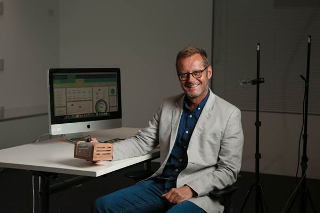Mar 20 2015
A group of researchers from the University of Sydney’s Indoor Environmental Quality (IEQ) Lab has developed world-leading technology to measure and improve the indoor human comfort factor of office buildings.
 University of Sydney’s Professor Richard de Dear with the world-leading technology SAMBA created by the IEQ Lab within the Faculty of Architecture, Design and Planning. Photo: Maja Baska.
University of Sydney’s Professor Richard de Dear with the world-leading technology SAMBA created by the IEQ Lab within the Faculty of Architecture, Design and Planning. Photo: Maja Baska.
The compact, box-shaped device known as SAMBA is a highly sophisticated unit created over the last two years by researchers from the IEQ Lab within the Faculty of Architecture, Design and Planning.
SAMBA is designed to measure air temperate and speed, humidity, light, sound and air pollutants – the key factors shown to have the greatest impact on an office worker’s health, comfort and productivity. The device is built on sensor technology that relays information about a building’s indoor environment back to a central computer for further analysis.
SAMBA is already capturing industry attention in Australia by becoming the People’s Choice winner of the ‘Weapons of Mass Creation’ innovation award at the Green Cities 2015 conference in Melbourne yesterday. It is also shortlisted for the Property Council of Australia’s 2015 Innovation & Excellence Awards to be announced in Sydney on 1 May.
The new technology is the brainchild of PhD student Tom Parkinson, who developed the idea with his brother and IEQ research assistant Alex Parkinson, under the leadership of Professor Richard de Dear, Head of Architectural Science at the University of Sydney.
Professor de Dear, a world-renowned expert in indoor climate and air quality who has been researching thermal comfort in buildings for the last 30 years, says that indoor environmental quality is just too important for companies to ignore today.
“In NSW, more than 90 per cent of office blocks and about 50 per cent of homes now have air-conditioning. Clearly the continuing transition towards an energy-efficient, low-carbon economy will have an impact on comfort levels within built environments. But what impact this will have on the people for whom buildings exist, is what we are interested in measuring.
“IEQ however, is a complex science. SAMBA will help to make sense of the science by giving companies the information or evidence to understand how efficiently and effectively their building is operating for the comfort of its people.”
According to Professor de Dear, SAMBA is designed to act as “a building’s eyes, ears, nose and skin”. Multiple units would ideally be placed in an office to capture the indoor environmental factors in different locations, which then gets fed back in real time to a central server for analysis.
“Until now the industry has been limited by technology and high costs to capture this information through one device. What we now have is a revolution in technology, which has been produced at a relatively low cost and will have high returns for companies and its employees,” said Professor de Dear.